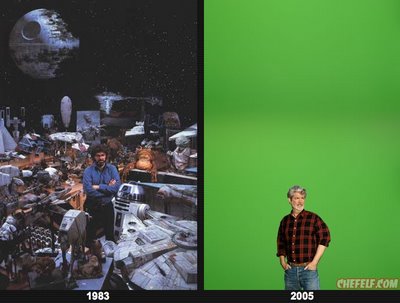Posts Tagged → movie
George Lucas 1983 – 2005
A Photo Essay. When words are simply unnecessary…
The Rainbow Monkeys
Cinematic Riddles, ovvero come tradurre in immagini titoli di film celebri…
George Lucas e JJ Abrams
Qualcuno ha lavorato di Photoshop su questa foto che ritrae George Lucas e JJ Abrams mentre conversano amabilmente…
[via joi ito]
Tetris. The movie
If Bunuel had seen Shrek

Un Chien Andalou nella versione di Ciprian Muresan…
Get real!

David Lynch ha le idee piuttosto chiare sulla faccenda del cinema visto sul (fottuto) telefonino…
Heaven and Hell
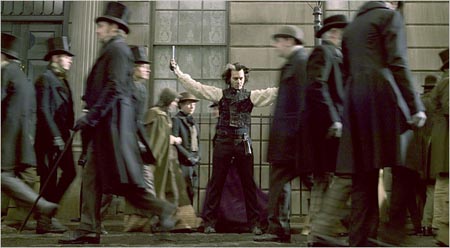
“Sweeney Todd” is a fable about a world from which the possibility of justice has vanished, replaced on one hand by vain and arbitrary power, on the other by a righteous fury that quickly spirals into madness. There may be a suggestion of hopefulness near the end, but you don’t see hope on the screen. What you see is as dark as the grave. What you hear — some of the finest stage music of the past 40 years — is equally infernal, except that you might just as well call it heavenly.”
[A. O. Scott sul NYTimes]
Rabbits
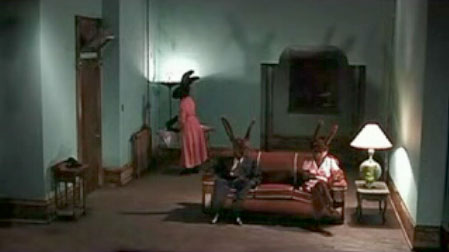
“In a nameless city deluged by a continuous rain… three rabbits live with a fearful mystery”.
Rabbits, di David Lynch. Per chi è stufo delle solite sitcom…
Il primo episodio è su YouTube
[via bunnylicious]
Sheena is a parasite
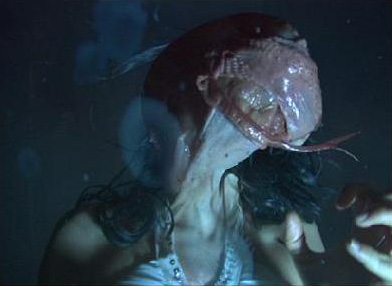
Il nuovo videoclip del sempre più visionario Chris Cunningham. La canzone è di un gruppo punkeggiante londinese dal significativo nome: The Horrors. Quindi niente elettronica stavolta. Ma pare che Cunnigham abbia dichiarato in proposito: “I’d find it hard to make a video for a track which sounded completely retro. It would just make me think of old things. To me, ‘Sheena is a Parasite’ sounds very special and futuristic.”
Leggendo tra le pagine di Director’s File dedicate al regista, ho scoperto che ci sono due progetti naufragati, che riguardano entrambi possibili riadattamenti cinematografici di capolavori della letteratura cyberpunk: Neuromancer di William Gibson e A Scanner Darkly di Philip K. Dick (quest’ultimo doveva avere addirittura la sceneggiatura di Charlie Kaufman). A Scanner Darkly è comunque diventato un film, diretto da Richard Linklater, per Neuromancer l’attesa continua…
Electroma

Due robot che vogliono diventare umani. Detto così sembra un po’ la storia di Pinocchio in versione cyber. Invece è la trama di Electroma, il film firmato dal duo musicale parigino Daft Punk. Il tema umano vs tecnologico era già centrale nella loro poetica musicale e nei loro videoclip. Aspettiamo il film godendoci il trailer; l’atmosfera è kubrickiana…
Buy it, use it, break it, fix it,
Trash it, change it, mail- upgrade it,
Charge it, point it, zoom it, press it,
Snap it, work it, quick- erase it,
Write it, cut it, paste it, save it,
Load it, check it, quick- rewrite it,
Plug it, play it, burn it, rip it,
Drag it, drop it, zip- unzip it,
Lock it, fill it, curl it, find it,
View it, coat it, jam- unlock it,
Surf it, scroll it, pose it, click it,
Cross it, crack it, twitch- update it,
Name it, rate it, tune it, print it,
Scan it, send it, fax- rename it,
Touch it, bring it, pay it, watch it,
Turn it, leave it, stop- format it.
(Daft Punk, Technologic, 2005)
[via blogyourmind]
Rocking Machine
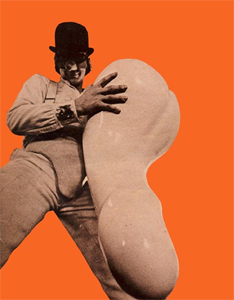
Lo scultore olandese Herman Makkink non è molto famoso. Se non per un’opera, entrata nell’immaginario collettivo grazie a Stanley Kubrick, che l’ha scelta per una scena di Arancia Meccanica. Sto parlando di Rocking Machine, la porno-scultura dondolante. Sono in vendita 6 nuovi esemplari dell’oggetto, oltre ad un originale restaurato del 1969.
[via cool hunting]
The Science of Sleep
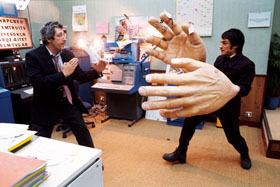
Alcune immagini dal nuovo film di Michel Gondry, The Science of Sleep. Continua l’esplorazione del mondo della mente…
[via mbf]
Cineconiglio

In uno spot per la Motorola un coniglio viaggia attraverso i grandi classici della storia del cinema. Da vedere.
La sposa messa a nudo…

La Sposa Cadavere messa a nudo dai suoi autori… anche. In attesa dell’arrivo del film nelle sale italiane (previsto per le feste natalizie), ci possiamo leggere un gustosissimo dietro le quinte che spiega, tecnicamente, come è stato realizzato. Si tratta del primo lungometraggio in stop motion costruito interamente montando foto digitali con Apple Final Cut Pro.
La conclusione dell’articolo è degna di nota: “Digital filmmaking has long been considered a trade-off compared to 35mm filmmaking; digital was cheaper or could do things impossible with film, but at a cost to overall image quality. With Corpse Bride, this is no longer the case.”
*update: scopro, con immenso giubilo, che il film esce il 28 di ottobre
La fabbrica di cioccolato
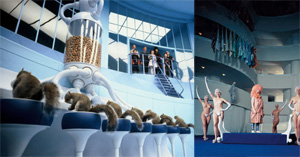
Che mi sarebbe piaciuto lo sapevo già. Ma un Tim Burton così scanzonato, trash e citazionista non me lo aspettavo. Il film è infarcito di richiami alla storia del cinema (i film di Ester Williams, Kubrick, Hitchcock), ma soprattutto, per la prima volta, Burton si auto-cita esplicitamente e senza ritegno. Tra tutte le perle gettate qua è là nella pellicola quella che preferisco è la scena in cui si tosano delle pecore dal vello rosa, evidente richiamo ai golfini d’angora total pink di Ed Wood. Ultima considerazione: in alcune scene la cura estetica di inquadrature, ombre e colori è talmente alta che sembra di vedere Matthew Barney (perdonate l’allucinazione da critico d’arte in sovraccarico di immagini).
Perfect Partner

Kim Gordon dei Sonic Youth, il videoartista Tony Oursler e il filmmaker Phil Morrison hanno realizzato un lungometraggio a sei mani. Questa la descrizione del progetto tratta dal comunicato stampa:
“Somewhere between Godard’s Pierrot Le Fou and a thundering free rock freak-out, Perfect Partner is a surreal psychodrama-cum-road movie celebrating our society’s enchantment with automobile culture.”
Cos’altro dire? Ah si, dopo alcune tappe europee il film sarà visibile anche in Italia, all’Auditorium di Roma per il Romaeuropa Festival. Il prossimo 12 ottobre.
Videoclip rules

Ci sono due videoclip in circolazione che vale davvero la pena di vedere. Uno è Only dei Nine Inch Nails, diretto da David Fincher (Fight Club). L’altro è All These Things That I’ve done dei The Killers, diretto da Anton Corbijn. Non lo so se è solo un collegamento tutto mio, ma a me questo lavoro di Corbijn fa pensare all’immenso Faster Pussycat! Kill! Kill! di Russ Meyer (trovate un trailer qui).
Plan 9

Plan 9 from Outer Space, il film culto di Ed Wood è disponibile in versione integrale su Internet Archive. Un’occasione imperdibile per rivedere i dischi volanti fatti con i coperchi delle pentole e le ultime, malinconiche immagini di Bela Lugosi. Per ricordarsi che il cinema è soprattutto un congegno che potenzia l’immaginazione.
Curiosità: la produzione fu finanziata da una congregazione battista, che costrinse l’intera troupe a farsi battezzare.
Migliore frase del film: Tutti siamo interessati a conoscere il futuro, perché è la che passeremo il resto della nostra vita
Che tempo fa

David Lynch fa un bizzarro report quotidiano sulle condizioni metereologiche a Los Angeles. Nel suo sito web si può vedere ogni giorno un piccolo video con il mitico regista che recita in ordine: luogo, data, ora, clima e temperatura. Ma prima, guarda fuori dalla finestra…
Era inevitabile

Probabilmente era un incontro inevitabile. La francese Orlan, regina incontrastata degli innesti corporali (si fa tagliuzzare e manipolare da decenni), reciterà nel prossimo film di David Cronenberg, intitolato Painkillers. Se in Crash il piacere proibito veniva dagli scontri automobilistici, che fondevano traumaticamente carne e metallo, stavolta il desiderio si stimola guardando operazioni chirurgiche in diretta. Proprio quello che faceva Orlan anni addietro. Facendosi operare da medici travestiti in vario modo (anche da conigli) mentre declamava versi.
Oppure, se preferite un riferimento più trash, proprio quello che facevano a Bisturi.
Pio Kenobi rules

da: www.cultodellaforza.it
“La sede italiana del Culto della Forza e’ intitolata a Pio Kenobi, santo maestro Jedi frutto della fusione fra Padre Pio e Obi Wan Kenobi”.
Una fugace apparizione per dire…
che Big Fish è molto più bello di quanto potessi immaginare.
Satellite evening
 Su Sky Cinema 3 sabato sera c’era Fantasmi da Marte, dell’insuperabile John Carpenter. Che immagina un futuro in cui la Terra colonizza Marte, con un governo tutto femminile. Una specie di società matriarcale. I due pezzi grossi della polizia sono anch’esse donne: una di colore e una bionda tossica (le pasticche magiche la salvano dalla zombificazione). Il malvivente dal cuore d’oro è nientemeno che Ice Cube (altro che Eminem) con il coattissimo nome di “Desolazione Williams”. Nonostante l’ambientazione ‘rosso Marte’, il film è una specie di western, dove al posto degli indiani ci sono dei minatori zombificati dagli spiriti di un’antica società marziana. Per finire il quadretto, il capo di quest’orda di indiavolati è un’incrocio tra il cantante dei Kiss e Marilyn Manson. Carpenter: un uomo una garanzia.
Su Sky Cinema 3 sabato sera c’era Fantasmi da Marte, dell’insuperabile John Carpenter. Che immagina un futuro in cui la Terra colonizza Marte, con un governo tutto femminile. Una specie di società matriarcale. I due pezzi grossi della polizia sono anch’esse donne: una di colore e una bionda tossica (le pasticche magiche la salvano dalla zombificazione). Il malvivente dal cuore d’oro è nientemeno che Ice Cube (altro che Eminem) con il coattissimo nome di “Desolazione Williams”. Nonostante l’ambientazione ‘rosso Marte’, il film è una specie di western, dove al posto degli indiani ci sono dei minatori zombificati dagli spiriti di un’antica società marziana. Per finire il quadretto, il capo di quest’orda di indiavolati è un’incrocio tra il cantante dei Kiss e Marilyn Manson. Carpenter: un uomo una garanzia.
Finito il film ho dato un’occhiata al Grande Fratello versione integrale. Che vi devo dire? Aveva ragione Bill Viola: “Life without editing, it seems, is just not that interesting”.

